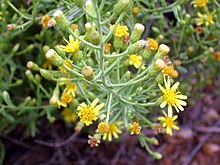Dittrichia viscosa, also known as false yellowhead,[2] woody fleabane,[3] sticky fleabane and yellow fleabane, is a flowering plant in the daisy family.
| Dittrichia viscosa | |
|---|---|
 | |
| Scientific classification | |
| Kingdom: | Plantae |
| Clade: | Tracheophytes |
| Clade: | Angiosperms |
| Clade: | Eudicots |
| Clade: | Asterids |
| Order: | Asterales |
| Family: | Asteraceae |
| Genus: | Dittrichia |
| Species: | D. viscosa |
| Binomial name | |
| Dittrichia viscosa | |
| Synonyms[1] | |
|
Synonymy
| |
Dittrichia viscosa is a highly branching perennial common throughout the Mediterranean Basin. It has long, narrow leaves that are pointed at both ends and have teeth along the edges and glandular hairs on the surfaces. One plant can produce many yellow flower heads each with as many as 16 ray florets and 44 disc florets.[4]
Originally, the species was found mainly in dry riverbeds and abandoned fields up to a 1500 m (5000 feet) elevation. Nowadays it is quite common in roadsides and ruderal habitats, even in urban areas. It is considered an invasive species in Australia.[5] The false yellowhead is a tough plant, very resistant to adverse conditions and degraded environments. It is important as food for the caterpillars of certain butterflies and moths, like Iolana iolas. The galls of the plants also are habitat for Myopites stylatus and Myopites inulaedyssentericae, both predators on the olive fly, which may be cause for its name in Catalán: Olivarda.[6]
Despite the fresh-looking green color of its leaves and its attractive inflorescence,[7] this plant is sticky and has a certain smell that most people find unpleasant. It contains an essential oil[8] and has been used in traditional medicine since ancient times, especially in the Levant, as an astringent.[9]
In Elba Island and Corsica it is now used by residents and tourists to heal stings from jellyfish, bees and wasps pressing fresh leaves on the skin with quick results. It is called in local dialect pescida.
A yellow dye substance has, since ancient times, been produced from its roots.[10]
It is an important plant in Catalan tradition, often mentioned in adages and proverbs. One adage says that: "No vos 'nemoreu, amor,de cap fadrina gallarda que és com la flor d'olivarda molt guapa, i dolenta d'olor." [My dear one, don't fall in love with any woman who only has good looks, she is like a false yellowhead flower: beautiful, but full of stench.]
- Subspecies[1]
- Dittrichia viscosa subsp. angustifolia (Bég.) Greuter
- Dittrichia viscosa subsp. maritima (Brullo & De Marco) Greuter
- Dittrichia viscosa subsp. revoluta (Hoffmanns. & Link) P.Silva & Tutin
- Dittrichia viscosa subsp. viscosa
Leaves, flowers and fruits
- Dittrichia viscosa habitus
- Seed heads
- Dittrichia viscosa. Flowerheads
- Leaves
- Utetheisa pulchella on Dittrichia viscosa
- Ruderal community of Dittrichia viscosa growing on the railway-side gravel next to Petah Tikva-Sgula railway station, Israel.
- Cypselae in situ
- Dittrichia viscosa growing in Giardino beach in Elba Island
References
External links
Wikiwand in your browser!
Seamless Wikipedia browsing. On steroids.
Every time you click a link to Wikipedia, Wiktionary or Wikiquote in your browser's search results, it will show the modern Wikiwand interface.
Wikiwand extension is a five stars, simple, with minimum permission required to keep your browsing private, safe and transparent.








